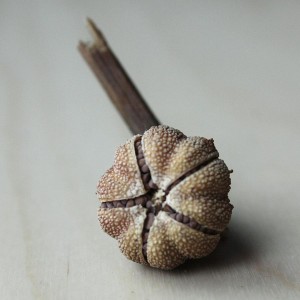Before the holidays got in full swing I got some pitcher plant seed and seedlings from Rob of The Pitcher Plant Project. Rob is super-enthusiastic about the genus Sarracenia and his blog bounces along with his energy. Check it out!
Rob’s a couple years ahead of me in making his own custom hybrids and has some really cool plants coming along. Here are some shots of the seedlings he sent me.
These first all come from the cross of Sarracenia Bug Bat x Diane Whittaker. This cross combines the seriously snakey-looking hood of S. minor with the frilly hood and wild patterning of S. leucophylla. The plants are young, but you can begin to see what promise they have. You can also see some of the variation that’s possible in a complex hybrid.
Two views of a seedling from the complex cross of Sarracenia ((purpurea ssp. pupurea x jonesii) x (leucophylla x rubra ssp. gulfensis)). All four parents of this hybrid share a rare recessive genetic mutation that prevents the leaves from producing red pigments, leaving this hybrid green green green from chlorophyll. One of Rob’s special interests is in these so-called “anthocyanin-free” (“AF”) plants, and I think they’re pretty amazing too. It really focuses your attention on the architecture of the pitchers.
Even if you’re only moderately technically-oriented you can make a lot of sense out of what’s going on with these AF plants in a paper by Phil Sheridan and Richard Mills, first published in Plant Science and now available online at Meadowview Biological Research Station: [ Presence of proanthocyanidins in mutant green Sarracenia indicate blockage in late anthocyanin biosynthesis between leucocyanidin and pseudobase ]. According to the paper the mutation that makes these plants green is one that affects the final stage in the metabolic pathway that creates red anthocyanin pigments.
And the plants kept going… Here are some first-year seedlings of the cross of Sarracenia Godzuki x ((flava x oreophila) x flava var. rugelli)…
And finally a big pile of seed from some really interesting crosses:
- S. oreophila “Veined” x Adrian Slack
- S. (oreophila x Royal Ruby) x Adrian Slack
- S. leucophylla x Adrian Slack
- S. (leucophylla x oreophila) x Brooks Hybrid
- S. (leucophylla x oreophila) x (Ladies in Waiting x Judith Hindle)
- S. Bug Scoop x Brooks Hybrid
- S. alata, Texas x flava var. maxima
They’re now in individual bags of damp sphagnum moss in the lower veggie crisper of the fridge. A couple more weeks of the cold treatment and then they’ll be ready to pot up.
If I manage to keep all the plants and even half of the new seedlings I germinate alive I’ll be up to my ankles in hungry young carnivores. To some people this might sound like a 1950s B horror movie, but as far as I’m concerned life doesn’t get much better than that!
Thanks, Rob!
















